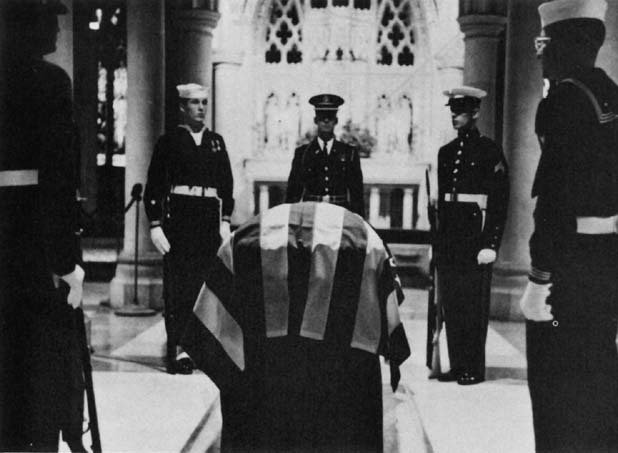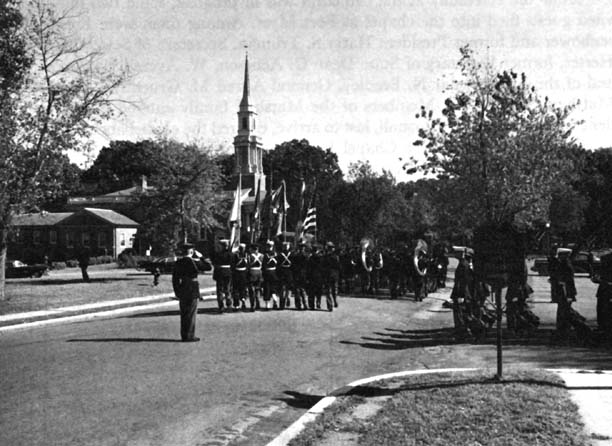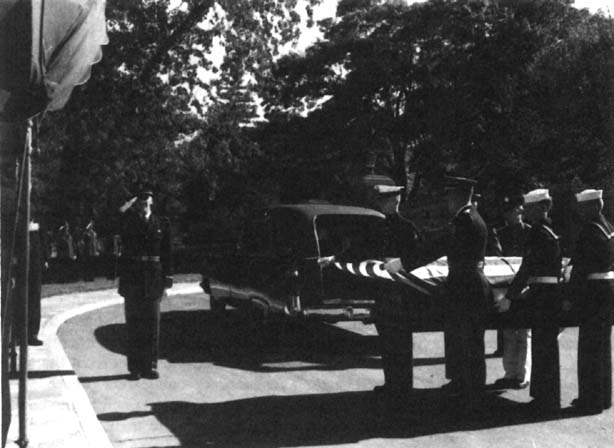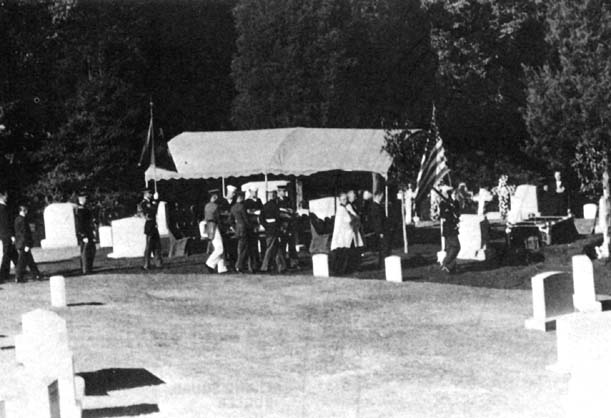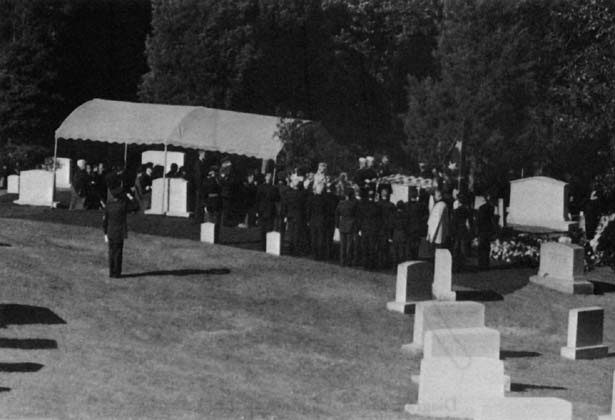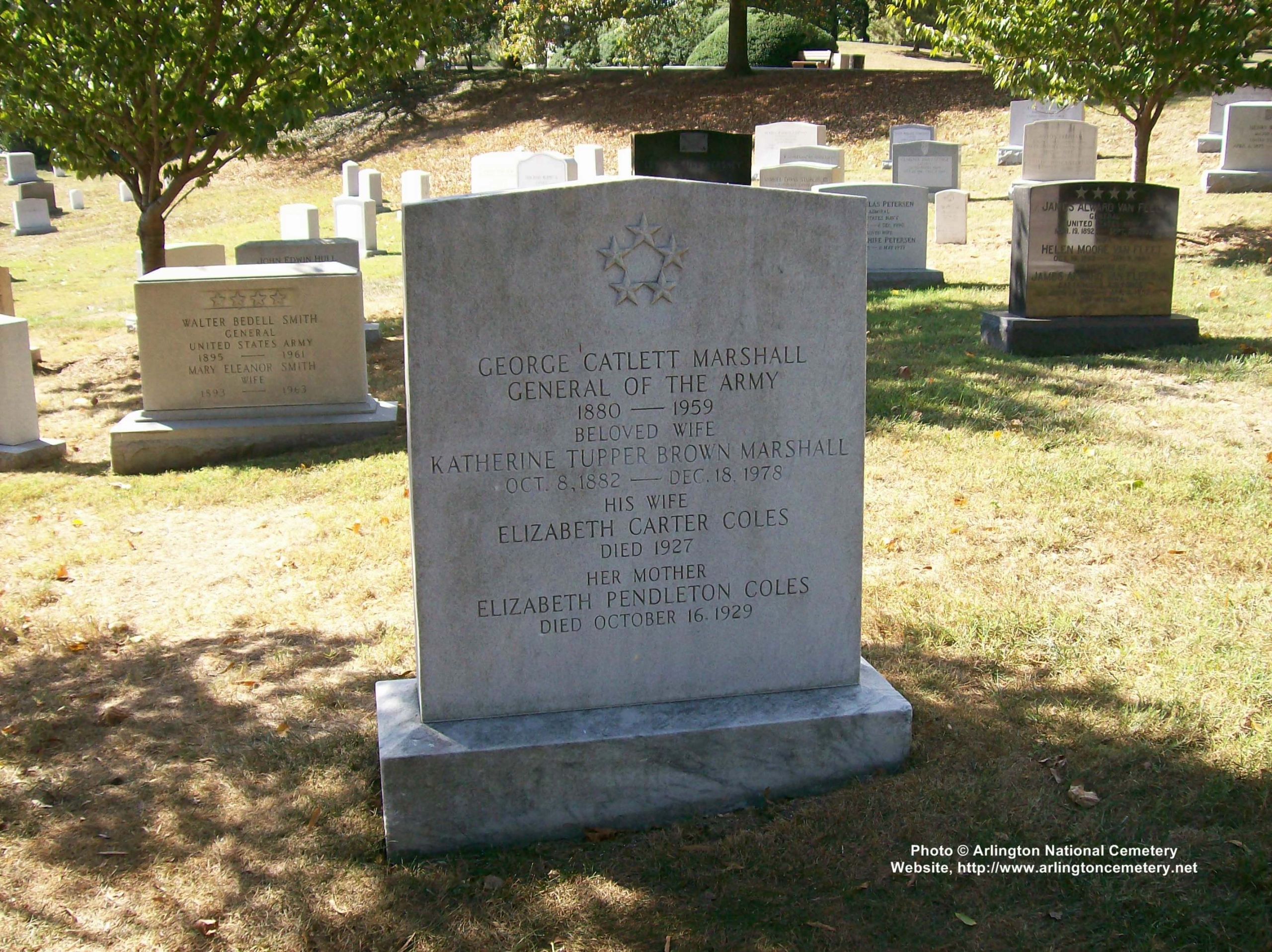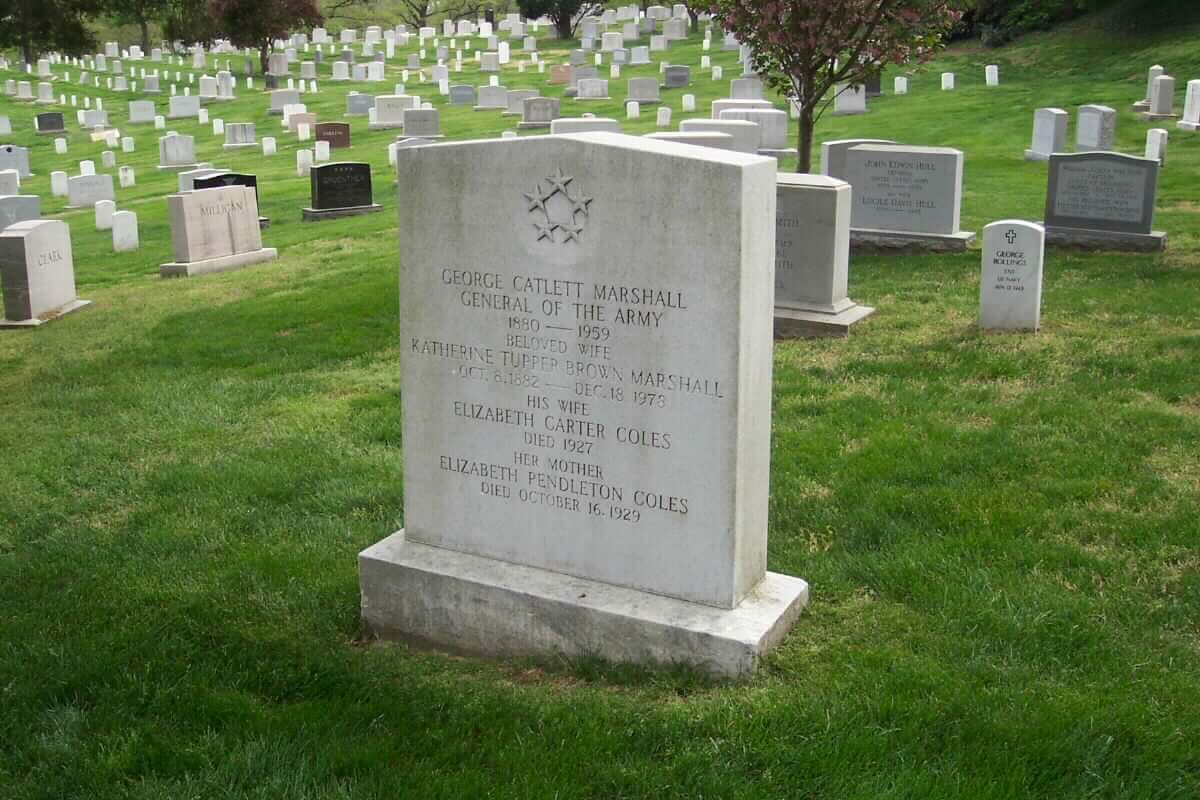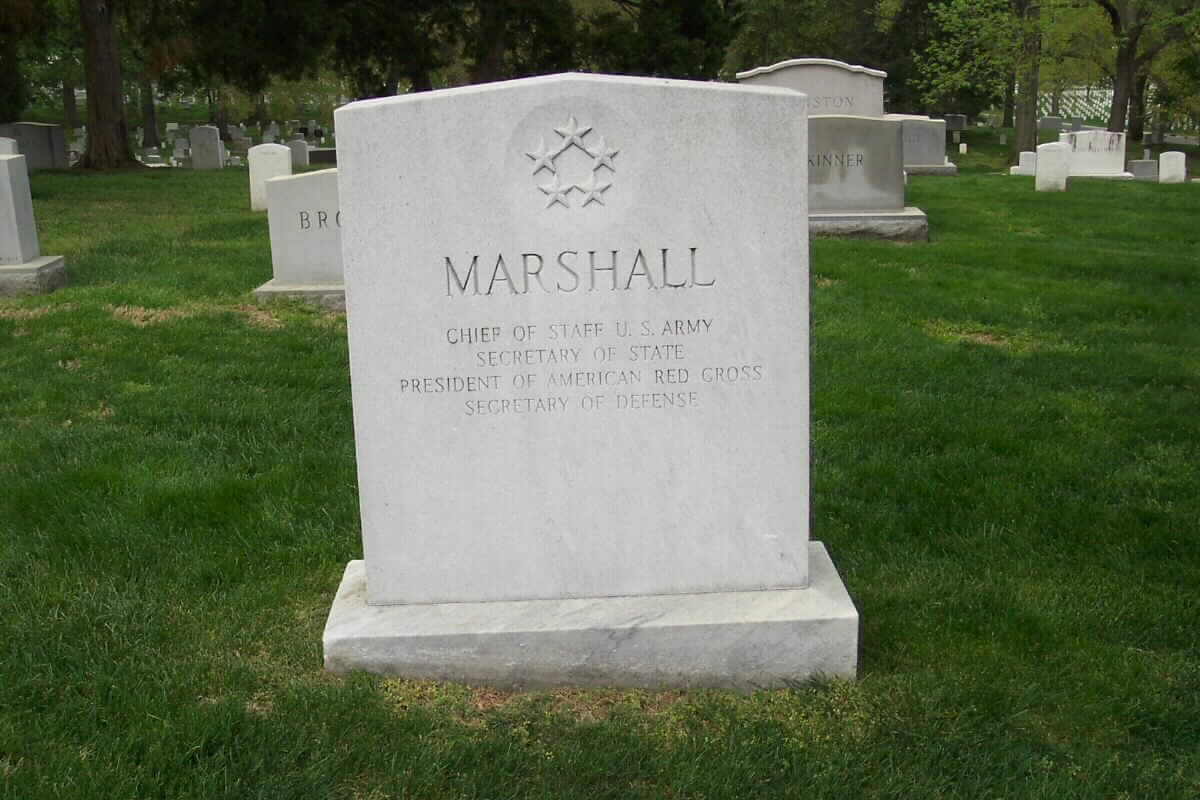George Catlett Marshall was one of the great American statesmen of the century. He played a crucial role in international affairs from 1939 to 1951 — the years that shaped the second half of the century. Until 1945, he was in the military service of the United States. As Chief of Staff of the U.S. Army from 1939 to 1945 he was, in the words of Winston Churchill, the “true architect of victory” in the West European arena of World War II.
Marshall was born on December 31, 1880, in Uniontown, Pennsylvania. He graduated from the Virginia Military Institute in 1901; afterwards, he was commissioned a Second Lieutenant. On September 1, 1939, he was promoted to Chief of Staff with the rank of General. Marshall was named General of the Army on December 16, 1944.
In a succession of positions of great responsibility between 1945 and 1951, Marshall devoted his efforts to the cause of international peace and security. He spent a year in China in 1945-46 as President Truman’s representative, attempting — without success — to bring about a peaceful resolution to the conflict between the nationalists and the communists. As Secretary of State from 1947 to 1949, he developed an economic program, the Marshall Plan, that turned the tide of Communism in war-ravaged Western Europe.
As Europeans endured unemployment, dislocation, and starvation in the wake of World War II’s devastation, the Marshall Plan embodied Marshall’s conviction that economic recovery and stability were vital underpinnings to the successful rebuilding of a democratic Europe. Marshall’s belief that America’s security and continued economic growth were inextricably linked to Europe’s well-being, which formed the cornerstone of his Plan. With the assistance of the Marshall Plan, Western Europe began to recover from the ravages of war. Marshall’s effort to include the Soviet Union and Eastern Europe in this grand design was rejected by Moscow. As Western Europe rebuilt, Europe was divided both economically and ideologically, and conflicting politics soon laid the ground for another war — The Cold War.
When it became evident that the gap between Eastern and Western Europe would not be bridged, and that the Western European states feared for their safety, Marshall was one of the leaders who created the North Atlantic Treaty Organization which would ensure the security of the West. The establishment of NATO in 1949 achieved a balance of power in Europe that endured until the end of the Cold War.
In the last official position as Secretary of Defense during 1950-51, Marshall oversaw the formation of an international force, under the United Nations, that turned back the North Korean invasion of South Korea.
Although he spent most of his life in the U.S. military, Marshall is best remembered as a true internationalist who sought peace for the world through cooperation and understanding among nations. It was a fitting tribute to a splendid career spent pursuing this ideal that Marshall received the Nobel Prize for Peace in 1953.
George Catlett Marshall died on October 16, 1959, and he was buried in Section 7 of Arlington National Cemetery.
On March 15, 1960, President Eisenhower announced that the space complex within the borders of Redstone Arsenal would become known as George C. Marshall Space Flight Center. As part of the formal dedication ceremony, held on September 8, 1960, for the new Marshall Center, a bust of General Marshall was unveiled by Mrs. Marshall and President Eisenhower. Today, the bust is still on display at the space center.
General of the Army George C. Marshall
Special Military Funeral
16-20 October 1959
General of the Army George C. Marshall died at Walter Reed General Hospital on 16 October 1959 at the age of seventy-eight. By virtue of his former positions as Chief of Staff of the Army and as Secretary of Defense, General Marshall was entitled to a Special Military Funeral and, as a former Secretary of State, he was entitled to the more elaborate honors of an Official Funeral. He received a Special Military Funeral, but in keeping with his known wishes and with what has been described as his “Spartan concept of propriety,” the rites for General Marshall were among the simplest ever conducted for a man of his rank and prestige.
The Commanding General, Military District of Washington, Maj. Gen. Charles K. Gailey, was responsible for arranging the ceremonies. Through an officer of his staff appointed as aide to the next of kin, General Gailey worked closely with Katherine T. Brown Marshall, the general’s widow, to see that all of her husband’s and her own wishes were met.
According to the plan worked out, General Marshall’s body was to lie in Bethlehem Chapel at the Washington National Cathedral for twenty-four hours, beginning at noon 19 October. On the 20th, the general’s body was to be taken to the post chapel at Fort Myer, Virginia, for the funeral service, which would be attended by a limited number of invited guests. A private burial service in Arlington National Cemetery was to follow. The gravesite, in Section 7, a little to the east of the Memorial Amphitheater, had been selected by General Marshall some years earlier and already contained the grave of the general’s first wife, Elizabeth Coles Marshall, and her mother.
On the day of the general’s death, President Dwight D. Eisenhower issued a proclamation ordering the flag flown at half-staff on all public buildings except the Capitol, at all military posts and naval stations in the United States, and at American facilities abroad. The flag was to be so displayed until after the burial service.
On 17 October General Marshall’s body was moved from Walter Reed General Hospital to the S. H. Hines Funeral Home, where it remained until 19 October. A half an hour before noon on the 19th, the commander of the Military District of Washington, General Gailey, accompanied by Armed Forces Police and Metropolitan motorcycle police, arrived at the funeral home to escort the general’s body to the Washington National Cathedral. The casket had already been placed in a hearse, and at 1145 General Gailey started the small motorized cortege toward the cathedral. Motorcycle police led the way, followed by Armed Forces Police, the escort commander, the hearse (accompanied by a mortician), and at the rear another Armed Forces Police car.
A few minutes before noon the military units taking part in the cathedral ceremonies were in position at the entrance to the Bethlehem Chapel. A joint honor cordon lined the walkway and entrance steps; a national color detail and personal flag bearer stood near the cordon; and the body bearers waited at the street end of the walkway. The body bearers included an enlisted man each from the Army, Marine Corps, Navy, Air Force, and Coast Guard and one cadet from Virginia Military Institute, General Marshall’s alma mater. This same body bearer detail would participate in ceremonies at the cathedral and in the graveside service on 20 October. A second team of body bearers of the same composition would participate in the funeral service at Fort Myer. With the body bearers at the chapel walkway were two members of the clergy: Canon Luther D. Miller of the Washington National Cathedral, a long-time friend of General Marshall’s and a former Army Chief of Chaplains, and the Reverend Franklin Moss, Jr., of General Marshall’s home church, St. James Episcopal, in Leesburg, Virginia. Inside the cathedral, a joint guard of honor was ready to post its first relief around the casket after it was placed in the Bethlehem Chapel.
When the cortege arrived the hearse stopped in front of the chapel entrance. The body bearers and clergy then moved to the rear of the hearse, and the color teams took station nearby. The escort commander meanwhile took his place at the chapel entrance.
The honor cordon presented arms as the body bearers removed the casket from the hearse. Then, preceded by the escort commander, the clergy, and the national color detail, and followed by the personal flag bearer, General Marshall’s casket was borne through the honor cordon into the chapel, where it was placed on a catafalque. The colors were posted without guards. The first relief of the guard of honor then entered the chapel, whereupon the guard commander dismissed the body bearers and posted his sentinels around the casket. General Marshall’s body remained in the Bethlehem Chapel which the public was permitted to enter to pay respects until noon on 20 October.
At 1400 on the 20th, the general’s body was taken from the cathedral for the movement to Fort Myer in a ceremony conducted by the same formation that had attended the arrival at the cathedral. Again the joint honor cordon formed along the steps and walkway outside the Bethlehem Chapel. The honor cordon saluted as Canon Miller and the Reverend Mr. Moss, followed by the national color detail, the body bearers with the casket, and the personal flag bearer, came out of the cathedral and moved to a hearse on the street. After the body bearers placed the casket in the hearse, General Gailey, the escort commander, and the clergy entered their vehicles (a mortician again was with the hearse), and the small cortege, accompanied by Metropolitan and Armed Forces Police, started for Fort Myer.
While the ceremony at the cathedral was in progress, some two hundred invited guests filed into the chapel at Fort Myer. Among them were President Eisenhower and former President Harry S. Truman, Secretary of State Christian A. Herter, former Secretary of State Dean G. Acheson, W. Averell Harriman, General of the Army Omar N. Bradley, General Alfred M. Gruenther, and General Matthew B. Ridgway. Members of the Marshall family entered after the President was seated; Mrs. Marshall, last to arrive, entered the chapel about 1425.
Outside the Fort Myer Chapel fourteen honorary pallbearers lined the entrance walkway: General Lyman L. Lemnitzer, Robert A. Lovett, General Walter Bedell Smith, Robert Woods Bliss, James Bruce, Admiral Harold R. Stark, General Charles D. Herron, Brig. Gen. Frank McCarthy, Col. Robert H. Fletcher, Col. William M. Spencer, Donald Cook, Lt. Col. Clarence J. George, M. Sgt. James W. Powder, and M. Sgt. William J. Heffner. In formation across the street from the entrance was an armed forces honor guard commanded by an Army captain with a staff of three: a lieutenant, junior grade, from the Navy, a lieutenant, junior grade, from the Coast Guard, and an Air Force lieutenant. The formation included the U.S. Army Band, an armed forces color detail, and an armed forces platoon of three squads. The color detail was made up of one color guard each from the Army and Marine Corps, two Army color bearers, one for the national colors and one for the Army colors, and one color bearer from each of the other services with the appropriate service colors. The armed forces platoon was commanded by a Marine Corps lieutenant. Each squad in the platoon had ten men, two each from the Army, Marine Corps, Navy, Coast Guard, and Air Force. One of the Army men in each squad was the leader.
The arriving motorcade halted on the street between the honor guard and Fort Myer Chapel, the hearse coming to a stop near the chapel entrance. After the clergy and body bearers had taken their positions at the rear of the hearse, the honor guard troops presented arms and the Army Band sounded ruffles and flourishes and played the “General’s March.” When the band began the hymn “Faith of Our Fathers,” the body bearers removed the casket from the hearse. Canon Miller and the Reverend Mr. Moss then led the way through the cordon of honorary pallbearers to the chapel entrance. At the entrance the body bearers placed the casket on a movable bier, and from that point two of the bearers moved the casket, following the clergy, to a position at the front of the chapel. The honorary pallbearers then entered the chapel and took their seats.
Canon Miller conducted the funeral service from the Episcopal Order for the Burial of the Dead. There was no eulogy. At the conclusion of the twenty-minute service, the honorary pallbearers, led out of the chapel by General Bradley, reformed their cordon at the entrance. Two body bearers meanwhile had moved to the front of the chapel to handle the casket. The clergy then led the funeral party from the chapel. President Eisenhower left the chapel by a side entrance. When the clergy reached the front entrance, the honor guard troops, who had remained in formation across the way, presented arms; the band sounded honors, then began a hymn. During the hymn the body bearers lifted the casket from the movable bier and returned it to the hearse. The honorary pallbearers proceeded to their cars. The members of the Marshall family, who had remained at the chapel entrance while the casket was placed in the hearse, went to their cars, and the small cortege of eight vehicles formed and moved toward the gravesite. The other mourners then dispersed.
Since early afternoon, a security cordon of troops from the 3d Infantry had been on station around the gravesite. A principal duty of these troops was to keep members of the press and the public at least 150 feet away from the gravesite in order to ensure the privacy of the burial service. Also in position some time before the cortege left the chapel were the saluting battery of the 3d Infantry, a firing squad, a bugler, the national color detail, the personal flag bearer, and the body bearer team. The members of the body bearer team were those who earlier had participated in the ceremonies at the Washington National Cathedral. The body bearers who handled the casket at the Fort Myer Chapel did not accompany the cortege to the gravesite.
The small procession, in order of march, included Mr. John C. Metzler, superintendent of Arlington National Cemetery; General Gailey, escort commander; the honorary pallbearers; the clergy; the hearse (accompanied by a mortician) ; the Marshall family; and a second cemetery representative. To reach the gravesite, the motorcade moved via Meigs Drive, Wilson Drive, and Roosevelt Drive. It came to a halt so that the rear of the hearse was aligned with a mat that had been laid from Roosevelt Drive east to the grave.
The honorary pallbearers, first to leave their cars, formed a cordon along the mat. The members of the Marshall family got out next and stood while the clergy, body bearers, national color detail, and personal flag bearer took positions at the rear of the hearse. When all were in place, the body bearers removed the casket from the hearse. Then, in procession, the national color detail, mortician, clergy, body bearers with the casket, and personal flag bearer moved through the cordon of honorary pallbearers to the grave. As the casket passed by, the honorary pallbearers fell in behind and moved to their graveside position. The Marshall family was escorted to the graveside by the cemetery superintendent.
The clergy then conducted the burial service. At its conclusion, the battery fired a 19-gun salute, the firing squad discharged the traditional three volleys, and the bugler sounded taps. As the sound of the bugle died away, the body bearers folded the flag that had draped the casket, and one of them, the cadet from Virginia Military Institute, presented the flag to Mrs. Marshall, thus concluding the simple rites for General Marshall. Mrs. Marshall placed a small bouquet of flowers on her husband’s casket and left the graveside.
Note: His brother-in-law, Tristram Tupper, Brigadier General, United States Army and author, is buried nearbyin Section 7 of Arlington National Cemetery
Michael Robert Patterson was born in Arlington and is the son of a former officer of the US Army. So it was no wonder that sooner or later his interests drew him to American history and especially to American military history. Many of his articles can be found on renowned portals like the New York Times, Washingtonpost or Wikipedia.
Reviewed by: Michael Howard



